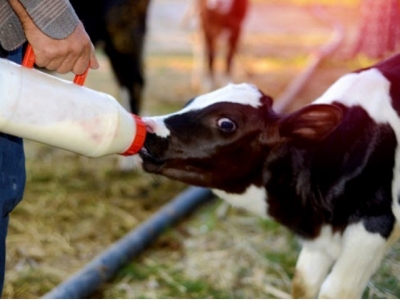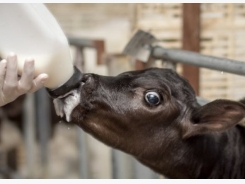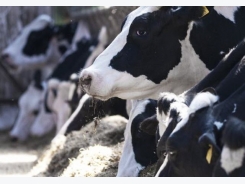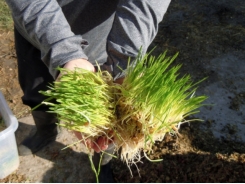Calf intestinal health linked to long-term performance

“There is mounting evidence that if you feed biomolecules to a calf the intestine can communicate with the rumen,” says researcher. © iStock
Calf gut health research needs to be part of a larger understanding of calf development, not an isolated study, as it can have lasting influence, say calf researchers.
Many of the practices currently used in rearing dairy calves need to be reexamined through the lens of whole animal health and for a longer-term, said Mike Steele, assistant professor in the department of agricultural, food and nutritional science with the University of Alberta.
Steele told FeedNavigator: “There’s a real need to look at the animal in multiple ways.”
Additive use
One of the ongoing trends in terms of the use of feed additives for calves has been a move toward use for “non-nutrition” purposes, said Steele. “There are a whole bunch of bioactives you can feed to animals from probiotics to prebiotics and specific molecules. We’re not actually feeding these for classical nutrition but to influence the gut,” he added.
The nutrients being used aren’t added to the diet to improve meat or milk production or quality, he said. Instead they’re used to promote an aspect of gut health like barrier function or growth.
Although much of the focus continues to be on the rumen, there could be more opportunity to work with the intestinal tract, he said. “There is mounting evidence that if you feed biomolecules to a calf, the intestine can communicate with the rumen,” he added.
The goal of the process would not be to alter the rumen but to produce a larger effect in the overall gut, he said. The research would be more intensive and look to account for the genes being expressed and how metabolites are working.
Dairy practice
Current practice with dairy calves is to remove them at birth from the dam, said Steele. While that action is taken to reduce transmission of disease it also may limit the flow of positive microbes to the new calf.
“The exchange of microbiota from the dam to the calf is important,” he said. “I understand why we have to separate the calf, but I think we’re missing a big chunk of microbiotal exchange.”
Early feeding practices, like how much milk is given and how often, or the way colostrum is fed also may need to be reassessed in terms of how they influence the development of the calf’s intestinal tract, he said.
“We’re focused on immunoglobulin transfer from colostrum before the gut closes, and what we do is feed one meal of colostrum or two meals of colostrum and then straight to milk replacer,” said Steele. “But there are many natural hormones produced by the cow [that we don’t give them] and that really sets up the calf for failure.”
In the last several years more attention has been given to the microbiome in calves, said Steele. However, the work needs to be expanded to look at how the microbiome interacts with the calf and how the gut functions.
Researchers need to focus on the structure of the gut and what genes are being expressed, he said.
Other future research could include how the gastrointestinal epithelium (GE) barrier function is regulated, examination of the layers of mucus in the lower gut, along with work to identify the nutrients that could be used to stimulate gastric hormones, Steele said in a written study on dairy calf health.
And better communication among researchers could establish consistent practices for the dissection of the GE, he said.
Industry stats
In the US there are more than 600,000 farms and ranches that deal with beef cattle, reported the US Department of Agriculture.
As of January there were about 92m head of cattle and calves both for beef and dairy production, a growth of about 3% from 2015, the agency said. The 2015 calf crop was about 34.3m with an estimated 6.29m head of beef replacement heifers.
The top producing states for cattle and calves from 2015 include Texas, Nebraska, Kansas, California and Oklahoma, the agency said. Together those states account for about 34.45m cattle and calves.
Beef perspective
When looking at the production of beef calves, there also is an interest in understanding the roll that gut health plays in relation to other health concerns, said Daniel Buskirk, associate professor in the department of animal science at Michigan State University.
Diarrhea can be a challenge in beef calves before weaning, he said. It can occur from the presence of bacteria like salmonella or campylobacter which can spread if calves are kept too close together.
“Those calves can go from healthy to death in two days,” he told us. “It’s something that producers really have to stay on top of.”
An additional benefit of catching any intestinal problems quickly is that they are less likely to result in long term challenges for the calf if they are treated early, he said. Digestive issues that last long enough to depress the immune system also may make the calf more susceptible to respiratory disease.
“If the calf is sick, it’s scouring, it’s likely to get dehydrated but it would set itself up for opportunistic pathogens to take hold and the mineral status of the calf could easily change,” said Buskirk. “Those young calves are tenuous on mineral status anyway, if they get low on selenium, copper or zinc [it] may potentially have a negative effect on immune function.”
Related news
Tools

Phối trộn thức ăn chăn nuôi

Pha dung dịch thủy canh

Định mức cho tôm ăn

Phối trộn phân bón NPK

Xác định tỷ lệ tôm sống

Chuyển đổi đơn vị phân bón

Xác định công suất sục khí

Chuyển đổi đơn vị tôm

Tính diện tích nhà kính

Tính thể tích ao




 Cutting silage? Here’s how to make the neighbours…
Cutting silage? Here’s how to make the neighbours…  Will dairy cows eat their hydroponic sprouts?
Will dairy cows eat their hydroponic sprouts?